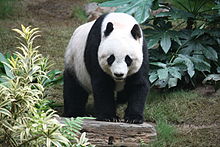
Ailuropoda melanoleuca

The giant panda (Ailuropoda melanoleuca; Chinese: 大熊猫; pinyin: dà xióng māo), also known as panda bear or simply panda, is a bear native to south central China. It is easily recognized by the large, distinctive black patches around its eyes, over the ears, and across its round body. The name 'giant panda' is sometimes used to distinguish it from the red panda. Though it belongs to the order Carnivora, the giant panda is a folivore, with bamboo shoots and leaves making up more than 99% of its diet. Giant pandas in the wild will occasionally eat other grasses, wild tubers, or even meat in the form of birds, rodents, or carrion. In captivity, they may receive honey, eggs, fish, yams, shrub leaves, oranges, or bananas along with specially prepared food. The giant panda lives in a few mountain ranges in central China, mainly in Sichuan, but also in neighbouring Shaanxi and Gansu. As a result of farming, deforestation, and other development, the giant panda has been driven out of the lowland areas where it once lived. The giant panda is a conservation-reliant vulnerable species. A 2007 report showed 239 pandas living in captivity inside China and another 27 outside the country. As of December 2014, 49 giant pandas lived in captivity outside China, living in 18 zoos in 13 different countries. Wild population estimates vary; one estimate shows that there are about 1,590 individuals living in the wild, while a 2006 study via DNA analysis estimated that this figure could be as high as 2,000 to 3,000. Some reports also show that the number of giant pandas in the wild is on the rise. In March 2015, conservation news site Mongabay stated that the wild giant panda population had increased by 268, or 16.8%, to 1,864. In 2016, the IUCN reclassified the species from 'endangered' to 'vulnerable'. While the dragon has often served as China's national symbol, internationally the giant panda has often filled this role. As such, it is becoming widely used within China in international contexts, for example, appearing since 1982 on gold panda bullion coins and as one of the five Fuwa mascots of the Beijing Olympics. For many decades, the precise taxonomic classification of the giant panda was under debate because it shares characteristics with both bears and raccoons. However, molecular studies indicate the giant panda is a true bear, part of the family Ursidae. These studies show it differentiated early (about 19 million years ago) from the main ursine stock; since it is the most basal member of the group, it is equidistant from all other extant ursids. The giant panda has been referred to as a living fossil. Despite the shared name, habitat type, and diet, as well as a unique enlarged bone called the pseudo thumb (which helps them grip the bamboo shoots they eat) the giant panda and red panda are only distantly related. The word panda was borrowed into English from French, but no conclusive explanation of the origin of the French word panda has been found. The closest candidate is the Nepali word ponya, possibly referring to the adapted wrist bone of the red panda, which is native to Nepal. The Western world originally applied this name to the red panda.
